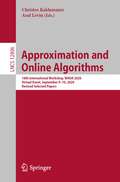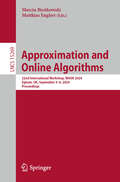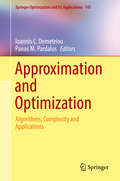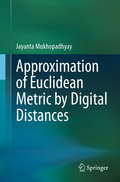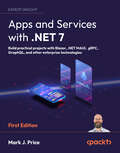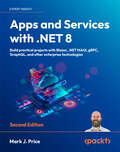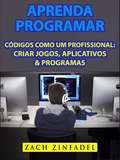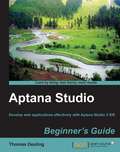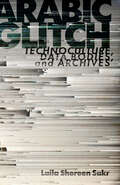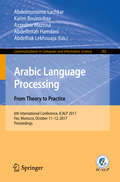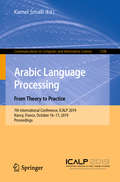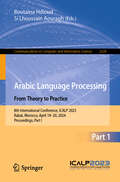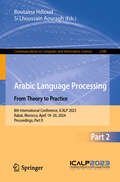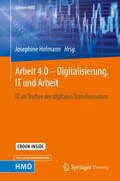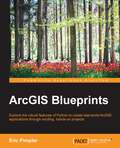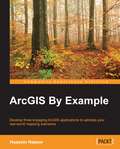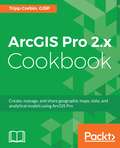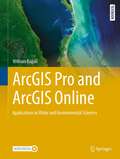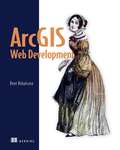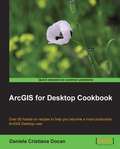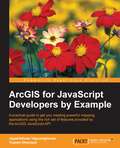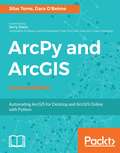- Table View
- List View
Approximation and Online Algorithms: 18th International Workshop, WAOA 2020, Virtual Event, September 9–10, 2020, Revised Selected Papers (Lecture Notes in Computer Science #12806)
by Christos Kaklamanis Asaf LevinThis book constitutes the thoroughly refereed workshop post-proceedings of the 18th International Workshop on Approximation and Online Algorithms, WAOA 2019, held virtually in September 2020 as part of ALGO 2020.The 15 revised full papers presented this book were carefully reviewed and selected from 40 submissions. Topics of interest for WAOA 2018 were graph algorithms, inapproximability results, network design, packing and covering, paradigms for the design and analysis of approximation and online algorithms, parameterized complexity, scheduling problems, algorithmic game theory, algorithmic trading, coloring and partitioning, competitive analysis, computational advertising, computational -finance, cuts and connectivity, geometric problems, mechanism design, resource augmentation, real-world applications.Chapter "Explorable Uncertainty in Scheduling with Non-Uniform Testing Times" is available open access under a Creative Commons Attribution 4.0 International License via link.springer.com.
Approximation and Online Algorithms: 21st International Workshop, WAOA 2023, Amsterdam, The Netherlands, September 7–8, 2023, Proceedings (Lecture Notes in Computer Science #14297)
by Andreas Wiese Jarosław ByrkaThis book constitutes the refereed proceedings of the 21st International Workshop on Approximation and Online Algorithms, WAOA 2023, held in Amsterdam, The Netherlands, during September 7–8, 2023The 16 full papers included in this book are carefully reviewed and selected from 43 submissions. The topics of WAOA 2023 were algorithmic game theory, algorithmic trading, coloring and partitioning, competitive analysis, computational advertising, computational finance, cuts and connectivity, FPT-approximation algorithms, geometric problems, graph algorithms, inapproximability results, mechanism design, network design, packing and covering, paradigms for the design and analysis of approximation and online algorithms, resource augmentation, and scheduling problems
Approximation and Online Algorithms: 22nd International Workshop, WAOA 2024, Egham, UK, September 5–6, 2024, Proceedings (Lecture Notes in Computer Science #15269)
by Marcin Bieńkowski Matthias EnglertThis book constitutes the refereed proceedings of the 22nd International Workshop on Approximation and Online Algorithms, WAOA 2024, held in Egham, UK, during September 5–6, 2024. The 15 full papers included in this book were carefully reviewed and selected from 47 submissions. They were organized in topical sections as follows: algorithmic game theory, algorithmic trading, coloring and partitioning, competitive analysis, computational advertising, computational finance, cuts and connectivity, FPT approximation algorithms, geometric problems, graph algorithms, inapproximability results, mechanism design, network design, packing and covering, paradigms for designing and analyzing approximation and online algorithms, resource augmentation, and scheduling problems.
Approximation and Online Algorithms: 4th International Workshop, Waoa 2006, Zurich, Switzerland, September 14-15, 2006, Revised Papers (Lecture Notes In Computer Science Ser. #4368)
by Christos Kaklamanis Asaf LevinThis book constitutes the thoroughly refereed workshop post-proceedings of the 18th International Workshop on Approximation and Online Algorithms, WAOA 2019, held virtually in September 2020 as part of ALGO 2020. <P><P> The 15 revised full papers presented this book were carefully reviewed and selected from 40 submissions. Topics of interest for WAOA 2018 were graph algorithms, inapproximability results, network design, packing and covering, paradigms for the design and analysis of approximation and online algorithms, parameterized complexity, scheduling problems, algorithmic game theory, algorithmic trading, coloring and partitioning, competitive analysis, computational advertising, computational -finance, cuts and connectivity, geometric problems, mechanism design, resource augmentation, real-world applications. Chapter "Explorable Uncertainty in Scheduling with Non-Uniform Testing Times" is available open access under a Creative Commons Attribution 4.0 International License via link.springer.com.
Approximation and Optimization: Algorithms, Complexity and Applications (Springer Optimization and Its Applications #145)
by Panos M. Pardalos Ioannis C. DemetriouThis book focuses on the development of approximation-related algorithms and their relevant applications. Individual contributions are written by leading experts and reflect emerging directions and connections in data approximation and optimization. Chapters discuss state of the art topics with highly relevant applications throughout science, engineering, technology and social sciences. Academics, researchers, data science practitioners, business analysts, social sciences investigators and graduate students will find the number of illustrations, applications, and examples provided useful. This volume is based on the conference Approximation and Optimization: Algorithms, Complexity, and Applications, which was held in the National and Kapodistrian University of Athens, Greece, June 29–30, 2017. The mix of survey and research content includes topics in approximations to discrete noisy data; binary sequences; design of networks and energy systems; fuzzy control; large scale optimization; noisy data; data-dependent approximation; networked control systems; machine learning ; optimal design; no free lunch theorem; non-linearly constrained optimization; spectroscopy.
Approximation of Euclidean Metric by Digital Distances
by Jayanta MukhopadhyayThis book discusses different types of distance functions defined in an n-D integral space for their usefulness in approximating the Euclidean metric. It discusses the properties of these distance functions and presents various kinds of error analysis in approximating Euclidean metrics. It also presents a historical perspective on efforts and motivation for approximating Euclidean metrics by digital distances from the mid-sixties of the previous century. The book also contains an in-depth presentation of recent progress, and new research problems in this area.
Apps and Services with .NET 7: Build practical projects with Blazor, .NET MAUI, gRPC, GraphQL, and other enterprise technologies
by Mark J. PriceBestselling author Mark Price is back to guide you through the coolest and most common technologies a .NET developer should know: Blazor, .NET MAUI, gRPC, GraphQL, SQL Server, Cosmos DB, OData, SignalR, Azure Functions, and more!Purchase of the print or Kindle book includes a free eBook in PDF format.Key FeaturesBuild services using a variety of technologies including Web API, OData, gRPC, GraphQL, SignalR, and Azure FunctionsLearn how to use specialized libraries to improve all aspects of your applications, including performance and localizationLeverage .NET MAUI to develop cross-platform desktop and mobile apps with easeBook DescriptionApps and Services with .NET 7 is for .NET 6 and .NET 7 developers who want to kick their C# and .NET understanding up a gear by learning the practical skills and knowledge they need to build real-world applications and services. It covers specialized libraries that will help you monitor and improve performance, secure your data and applications, and internationalize your code and apps.With chapters that put a variety of technologies into practice, including Web API, OData, gRPC, GraphQL, SignalR, and Azure Functions, this book will give you a broader scope of knowledge than other books that often focus on only a handful of .NET technologies. It covers the latest developments, libraries, and technologies that will help keep you up to date.You'll also leverage .NET MAUI to develop mobile apps for iOS and Android as well as desktop apps for Windows and macOS.What you will learnLearn how to build more efficient, secure, and scalable apps and servicesLeverage specialized .NET libraries to improve your applicationsImplement popular third-party libraries like Serilog and FluentValidationBuild cross-platform apps with .NET MAUI and integrate with native mobile featuresGet familiar with a variety of technologies for implementing services like gRPC and GraphQLExplore Blazor WebAssembly and use open-source Blazor component librariesStore and manage data locally and in the cloud with SQL Server and Cosmos DBWho this book is forThis book is for .NET developers interested in exploring more specialized libraries and implementation fundamentals behind building services and apps.You'll need to know your way around .NET and C# quite well before you can dive in, so if you want to work your way up to this book, pick up Mark's other .NET book, C# 11 and .NET 7 – Modern Cross-Platform Development Fundamentals, first.
Apps and Services with .NET 8: Build practical projects with Blazor, .NET MAUI, gRPC, GraphQL, and other enterprise technologies
by Mark J. PriceBestselling author Mark Price is back to guide you through the latest and most common technologies a .NET developer should know: Blazor Full Stack, ASP.NET Core MVC, ASP.NET Core Minimal APIs, .NET MAUI, gRPC, GraphQL, SQL Server, Cosmos DB, SignalR, Azure Functions, and more! Purchase of the print or Kindle book includes a free eBook in PDF format.Key FeaturesUse specialized libraries to improve all aspects of your apps, including performance, security, and localizationHarness the full potential of .NET using cloud-native data stores like Cosmos DB, and unlock scalability, performance, and resilience in your service implementationsUnleash the capabilities of Blazor Full Stack and.NET MAUI to develop stunning, truly cross-platform apps for web and mobileBook DescriptionElevate your practical C# and .NET skills to the next level with this new edition of Apps and Services with .NET 8. With chapters that put a variety of technologies into practice, including Web API, gRPC, GraphQL, and SignalR, this book will give you a broader scope of knowledge than other books that often focus on only a handful of .NET technologies. You’ll dive into the new unified model for Blazor Full Stack and leverage .NET MAUI to develop mobile and desktop apps. This new edition introduces the latest enhancements, including the seamless implementation of web services with ADO.NET SqlClient's native Ahead-of-Time (AOT) support. Popular library coverage now includes Humanizer and Noda Time. There’s also a brand-new chapter that delves into service architecture, caching, queuing, and robust background services. By the end of this book, you’ll have a wide range of best practices and deep insights under your belt to help you build rich apps and efficient services.What you will learnFamiliarize yourself with a variety of technologies to implement services, such as gRPC and GraphQLStore and manage data locally and cloud-natively with SQL Server and Cosmos DBUse ADO.NET SqlClient to implement web services with native AOT publish supportLeverage Dapper for improved performance over EF CoreImplement popular third-party libraries such as Serilog, FluentValidation, Humanizer, and Noda TimeExplore the new unified hosting model of Blazor Full StackWho this book is forThis book is for .NET developers interested in exploring more specialized libraries and implementation fundamentals behind building services and apps. You’ll need to know your way around .NET and C# quite well before you can dive in, so if you want to work your way up to this book, you can pick up Mark’s other .NET book, C# 12 and .NET 8 – Modern Cross-Platform Development Fundamentals, first.
Aprenda programar códigos como um Profissional: Criar jogos, Aplicativos & Programas
by Zach ZinfadelAprenda programar códigos como um Profissional: Criar jogos, Aplicativos & Programas por Zach Zinfadel Com este livro você não aprende só programação, mas também aborda tópicos que as aulas e outros livros não ensinam. Fornece também instruções específicas e fáceis de seguir, passos de como criar códigos de forma correta. Itens inclusos: - Tutoriais de programação em HTML e JavaScript. - Introdução à programação e códigos. - O que são variáveis e como usá-las. - Tudo sobre arrays e declarações lógicas. - Tudo sobre funções e como elas funcionam. - Como criar seu primeiro programa. >>> Clique acima para comprar instantaneamente! Gênero: COMPUTADORES / Programação / Geral Gênero Secundário: COMPUTADORES / Programação Web / Web Língua: Português BR
Aptana RadRails: An IDE for Rails Development
by Javier RamirezThis book is for Ruby on Rails developers who want to make the most of the framework by using an Integrated Development Environment. Even though the book explains everything you need to follow the contents, the focus is on how to use the tool and not on the Rails framework itself, so previous working knowledge of Rails is highly advisable. Previous knowledge of Eclipse is not necessary.
Aptana Studio Beginner's Guide
by Thomas DeulingAccompanied by the plenty of example code and step-by-step instructions, this book will escalate you from a novice to an expert in no time. This book is for anyone who is looking for an IDE for effectively developing web applications. You will find this book interesting if you are working with common web technologies such as HTML5, JavaScript, or PHP. This book assumes no prior knowledge of Aptana Studio 3 or the named web technologies.
Arabic Glitch: Technoculture, Data Bodies, and Archives
by Laila Shereen SakrArabic Glitch explores an alternative origin story of twenty-first century technological innovation in digital politics—one centered on the Middle East and the 2011 Arab uprisings. Developed from an archive of social media data collected over the decades following the 2003 U.S. invasion of Iraq, this book interrogates how the logic of programming technology influences and shapes social movements. Engaging revolutionary politics, Arab media, and digital practice in form, method, and content, Laila Shereen Sakr formulates a media theory that advances the concept of the glitch as a disruptive media affordance. She employs data analytics to analyze tweets, posts, and blogs to describe the political culture of social media, and performs the results under the guise of the Arabic-speaking cyborg VJ Um Amel. Playing with multiple voices that span across the virtual and the real, Sakr argues that there is no longer a divide between the virtual and embodied: both bodies and data are physically, socially, and energetically actual. Are we cyborgs or citizens—or both? This book teaches us how a region under transformation became a vanguard for new thinking about digital systems: the records they keep, the lives they impact, and how to create change from within.
Arabic Language Processing: 6th International Conference, ICALP 2017, Fez, Morocco, October 11–12, 2017, Proceedings (Communications in Computer and Information Science #782)
by Abdelmonaime Lachkar Karim Bouzoubaa Azzedine Mazroui Abdelfettah Hamdani Abdelhak LekhouajaThis book constitutes revised selected papers from the 6th International Conference on Arabic Language Processing, ICALP 2017, held in Fez, Morocco, in October 2017. The 18 full papers presented in this volume were carefully reviewed and selected from 55 submissions. They were organized in topical sections named: machine translation systems; speech recognition and synthesis; text categorization, clustering and summarization; information retrieval systems; and Arabic NLP tools and applications.
Arabic Language Processing: 7th International Conference, ICALP 2019, Nancy, France, October 16–17, 2019, Proceedings (Communications in Computer and Information Science #1108)
by Kamel SmaïliThis book constitutes revised selected papers from the 7th International Conference on Arabic Language Processing, ICALP 2019, held in Nancy, France, in October 2019. The 21 full papers presented in this volume were carefully reviewed and selected from 38 submissions. They were organized in topical sections named: Arabic dialects and sentiment analysis; neural techniques for text and speech; modeling modern standard Arabic; resources: analysis, disambiguation and evaluation.
Arabic Language Processing: 8th International Conference, ICALP 2023, Rabat, Morocco, April 19–20, 2024, Proceedings, Part I (Communications in Computer and Information Science #2339)
by Boutaina Hdioud Si Lhoussain AouraghThis two-volume set, CCIS 2339 and CCIS 2340, constitutes the refereed proceedings of the 8th International Conference on Arabic Language Processing, ICALP 2023, held in Rabat, Morocco, during April 19–20, 2024. The 30 full papers and 11 short papers presented in these two volumes were carefully reviewed and selected from 107 submissions. The papers are organized in the following topical sections: Part I: Learning Arabic and dialectal and Sentiment Analysis; Advancements in Deep Learning for Arabic Language Processing: Generation, Translation, and QA. Part II: Linguistic Resources for Arabic NLP; Various analysis of Arabic.
Arabic Language Processing: 8th International Conference, ICALP 2023, Rabat, Morocco, April 19–20, 2024, Proceedings, Part II (Communications in Computer and Information Science #2340)
by Boutaina Hdioud Si Lhoussain AouraghThis two-volume set, CCIS 2339 and CCIS 2340, constitutes the refereed proceedings of the 8th International Conference on Arabic Language Processing, ICALP 2023, held in Rabat, Morocco, during April 19–20, 2024. The 30 full papers and 11 short papers presented in these two volumes were carefully reviewed and selected from 107 submissions. The papers are organized in the following topical sections: Part I: Learning Arabic and dialectal and Sentiment Analysis; Advancements in Deep Learning for Arabic Language Processing: Generation, Translation, and QA. Part II: Linguistic Resources for Arabic NLP; Various analysis of Arabic.
Arbeit 4.0 – Digitalisierung, IT und Arbeit: It Als Treiber Der Digitalen Transformation (Edition HMD)
by Josephine HofmannAktuelle und spannende Fachbeiträge zur Arbeitswelt der Zukunft.<P><P> Diskutiert Arbeitsgestaltung und Qualifizierung im Zeitalter der Digitalisierung.<P> Liefert differenzierte Einblicke zu IT-Einsatz und Wirkung in verschiedenen Branchen.<P> Die Digitalisierung transformiert die Arbeitswelt in vieler Hinsicht: Arbeitsplätze werden zunehmend mobil und flexibel, Arbeitsprozesse durch Algorithmen gesteuert, Roboter sind die neuen „Kollegen“ in der Industrie und im Dienstleistungssektor. Dieser Band der „Edition HDM“ erörtert viele zentrale Fragen rund um die Transformation der Arbeitswelt von heute und morgen. In ihren Beiträgen über den Einfluss der massiven Digitalisierung auf unterschiedliche Branchen und Arbeitsbereiche diskutieren die Autorinnen und Autoren diverse Aspekte wie: • den Einfluss der Digitalisierung im Versandhandel und auf die Wissensarbeit. • die Interaktion von Mensch und Roboter in der Fabrik 4.0.• den Wert der menschlichen Arbeitsleistung in der Zukunft.• die Anforderungen an Qualifizierung.• die Möglichkeiten für Mitarbeiter, die Arbeit in der vernetzten Wirtschaft 4.0 proaktiv mitzugestalten. Unter der Herausgeberschaft von Josephine Hofmann, Leiterin des Competence Center Business Performance Management am Fraunhofer IAO in Stuttgart, entsteht so ein Sammelband, der sich als Teil der aktuellen Debatte um die digitale Transformation der Arbeitswelt versteht. Nicht nur Wissenschaftler erhalten neue Denkanstöße für ihre Forschung, auch Entscheider in Wirtschaft und Politik sowie Verantwortliche in den Bereichen Bildung, Fortbildung und Personalentwicklung können aus der Lektüre des Buches wertvolle Erkenntnisse über die Arbeit von heute und die Gestaltung der zunehmend digitalisierten Arbeitswelt von morgen gewinnen.
ArcGIS Blueprints
by Eric PimplerExplore the robust features of Python to create real-world ArcGIS applications through exciting, hands-on projects About This Book * Get to grips with the big world of Python add-ins and wxPython in GUI development to implement their features in your application * Integrate advanced Python libraries, ArcPy mapping, and data access module techniques to develop a mapping application * Construct a top-notch intermediate-to-advanced project by accessing ArcGIS Server and ArcGIS Online resources through the ArcGIS REST API using a project-based approach Who This Book Is For If you have prior experience building simple apps with ArcGIS and now have a fancy for developing a more challenging and complex desktop application in ArcGIS, then this book is ideal for you. What You Will Learn * Automate the creation of creative output data visualizations including maps, charts, and graphs * Explore ways to use the ArcPy Mapping module and Data-driven Pages to automate the creation of map books in your own project * Develop applications that use the Plotly platform and library to create stunning charts and graphs that can be integrated into ArcGIS Desktop * Build tools that access REST services and download data to a local geodatabase * Design, build, and integrate advanced GUIs with wxPython and ArcGIS Desktop in ArcGIS * Get clued up about constructing applications that export data to Google Earth Pro to automate time-consuming complex processes * Maximize the access of ArcGIS Server and ArcGIS Online using the ArcGIS REST API with Python In Detail This book is an immersive guide to take your ArcGIS Desktop application development skills to the next level It starts off by providing detailed description and examples of how to create ArcGIS Desktop Python toolboxes that will serve as containers for many of the applications that you will build. We provide several practical projects that involve building a local area/community map and extracting wildfire data. You will then learn how to build tools that can access data from ArcGIS Server using the ArcGIS REST API. Furthermore, we deal with the integration of additional open source Python libraries into your applications, which will help you chart and graph advanced GUI development; read and write JSON, CSV, and XML format data sources; write outputs to Google Earth Pro, and more. Along the way, you will be introduced to advanced ArcPy Mapping and ArcPy Data Access module techniques and use data-driven Pages to automate the creation of map books. Finally, you will learn advanced techniques to work with video and social media feeds. By the end of the book, you will have your own desktop application without having spent too much time learning sophisticated theory. Style and approach This is an easy-to-follow, project-based guide that guides you through the whole ArcGIS theme with practical, real-world examples and a systematic approach.
ArcGIS By Example
by Hussein NasserDevelop three engaging ArcGIS applications to address your real-world mapping scenarios About This Book * Design, build and run ArcGIS applications using ArcObjects SDK * Extend ArcGIS objects and use add -ins to deploy applications on top of ArcGIS * An example-centric practical guide to help you understand mapping scenarios with ArcGIS Who This Book Is For If you are an application developer and wish to enhance your skills for the GIS domain with ArcGIS, then this book is for you. Previous experience with ArcGIS is not required. What You Will Learn * Use essential ArcGIS code to query geodatabases * Communicate with ArcGIS maps, with the help of critical designing and optimisation tips * Highlight and interact with objects on your map * Query ArcGIS geodatabases with related data to display your information on ArcGIS * Edit your underlying geodatabase * Explore strategies for the adaptation of various types of spatial analysis techniques into the GIS framework * Analyze tools for Geographical Information Systems and remote sensing * Experience ArcGIS's advanced tools for manipulation of shapefiles and geodatabases In Detail ArcGIS is a geographic information system (GIS) for working with maps and geographic information. It is considered the turnkey solution to creating and sharing interactive maps. ArcGIS is designed to work the way you work. With nothing to install and set up, ArcGIS helps you make your work productive from day one. The book covers the design and development of three ArcGIS applications to guide the readers in crafting their own GIS solution as per their requirements. The book begins by giving you a refresher on the concepts of ArcGIS. Without wasting any time, you'll begin with developing your first ArcGIS application. You will be developing a cell tower analysis tool. Following this, you will be guided through mapping signal strength and real - time manoeuvring in your GIS system. You will then move on to the second application of the book: a restaurant mapping system. The application will allow tourists to browse restaurants on a map, according to their preferences. Next, you will learn how to work with reviews and ratings and also cover some of the advanced searching options offered by ArcGIS. You will then make use of advanced ArcObjects to develop your third application: an excavation planning manager. The book will conclude by teaching you how work out excavation cost calculations and also saving and retrieving your excavation designs. Style and approach The book offers an enhanced way of learning ArcGIS, through the design and development of three applications throughout its length. In addition to this the book also covers features that you can add to your application as you develop each one covered in the book.
ArcGIS Pro 2.x Cookbook: Create, manage, and share geographic maps, data, and analytical models using ArcGIS Pro
by Tripp CorbinCreating and Sharing Maps and Data using ArcGIS Pro Key Features Leverage the power of ArcGIS to build beautiful 2D and 3D maps. Work with ArcGIS to analyze and process data. Extend the power of ArcGIS to ArcGIS Online to create and edit content. Book Description ArcGIS is Esri's catalog of GIS applications with powerful tools for visualizing, maintaining, and analyzing data. ArcGIS makes use of the modern ribbon interface and 64-bit processing to increase the speed and efficiency of using GIS. It allows users to create amazing maps in both 2D and 3D quickly and easily. If you want to gain a thorough understanding of the various data formats that can be used in ArcGIS Pro and shared via ArcGIS Online, then this book is for you. Beginning with a refresher on ArcGIS Pro and how to work with projects, this book will quickly take you through recipes about using various data formats supported by the tool. You will learn the limits of each format, such as Shapefiles, Geodatabase, and CAD files, and learn how to link tables from outside sources to existing GIS data to expand the amount of data that can be used in ArcGIS. You'll learn methods for editing 2D and 3D data using ArcGIS Pro and how topology can be used to ensure data integrity. Lastly the book will show you how data and maps can be shared via ArcGIS Online and used with web and mobile applications. What you will learn Edit data using standard tools and topology Convert and link data together using joins and relates Create and share data using Projections and Coordinate Systems Access and collect data in the field using ArcGIS Collector Perform proximity analysis and map clusters with hotspot analysis Use the 3D Analyst Extension and perform advanced 3D analysis Share maps and data using ArcGIS Online via web and mobile apps Who this book is for GIS developers who are comfortable using ArcGIS, and are looking to increase their capabilities and skills, will find this book useful.
ArcGIS Pro and ArcGIS Online: Applications in Water and Environmental Sciences (Springer Textbooks in Earth Sciences, Geography and Environment)
by William BajjaliThis textbook serves as a practical guide for undergraduate and graduate students in geology, hydrology, ecology, and environmental sciences, teaching them applied GIS techniques. Presented as a step-by-step tutorial across seventeen chapters, the book starts with the fundamentals of GIS and progresses to real-life examples from geology and water resources. The focus is on ESRI's ArcGIS Pro, covering various tools for spatial, geostatistical, network, and 3-D analysis. Additionally, it explores ArcGIS Online and working with web apps like Web Map, StoryMaps, and GEO App.GIS applications, especially in water and environmental problem-solving, are rapidly growing worldwide. The demand for GIS experts utilizing spatial analysis in environmental science remains high. This textbook equips users with the necessary knowledge to become effective mappers and spatial analysts in the fields of environment, geosciences, and water resources, employing the latest state-of-the-art methodology.Each chapter provides exercises and supplementary materials available for download on SpringerLink, along with additional links for further learning opportunities.
ArcGIS Web Development
by Rene RubalcavaSummaryArcGIS Web Development is an example-rich tutorial designed to teach developers to use the ArcGIS JavaScript API to build custom GIS web applications.About the TechnologyNow you can unshackle your GIS application from a workstation! Using the ArcGIS JavaScript API, developers can build mobile and web-based maps and applications driven by ArcGIS data and functionality. Experienced ArcGIS developers will find that the familiar development environment provides a smooth transition to the web. Web developers new to GIS will be pleased by how easily they can apply their existing skills to GIS applications.Purchase of the print book includes a free eBook in PDF, Kindle, and ePub formats from Manning Publications.About the BookArcGIS Web Development is an example-rich guide that teaches you to use the ArcGIS JavaScript API to build custom GIS web applications. The book begins with easy-to-follow examples that introduce readers to the ArcGIS JavaScript API and show how you can apply simple customizations. As the book progresses, you'll explore a full-scale, web-mapping application. By the end you will be able to build web apps that have features you'd ordinarily expect to find only in dedicated GIS applications.Written for web developers familiar with JavaScript and basic GIS concepts. Experience with ArcGIS is helpful, but not necessary.What's InsideBuild web-based GIS applicationsCustomize the ArcGIS Javascript API toolsBring ArcGIS data to the webCreate secure logins for mobile app usersAbout the AuthorRene Rubalcava is the cofounder of SmartGeoTech, Inc., a GIS development company specializing in Esri technologies.Table of ContentsPART 1 ARCGIS JAVASCRIPT FOUNDATIONGIS as a toolIntroducing core API conceptsWorking with the REST APIPART 2 SAMPLE USE CASEBuilding an applicationDeveloping a custom data-collection applicationBuilding a desktop browser applicationAdvanced techniquesAPPENDICESSetting up your environmentDojo basicsConfiguring a proxy
ArcGIS for Desktop Cookbook
by Daniela Cristiana DocanThis book is a good companion to get you quickly acquainted with everything you need to increase your productivity with the ArcGIS Desktop. It would be helpful to have a bit of familiarity with basic GIS concepts. If you have no previous experience with ArcGIS, this book will still be helpful for you because it will help you catch up to the acquainted users from a practical point of view.
ArcGIS for JavaScript Developers by Example
by Jayakrishnan Vijayaraghavan Yogesh DhanapalA practical guide to get you creating powerful mapping applications using the rich set of features provided by the ArcGIS JavaScript API About This Book * Unshackle your GIS application from a workstation! Get running with three major web mapping projects covering all the important aspects of the ArcGIS JavaScript API. * Set a strong foundation for the ArcGIS JavaScript API and modular coding with dojo. * Gain a crystal clear understanding of the ArcGIS JavaScript, and become skilled in creating exciting and interesting geospatial apps. Who This Book Is For This book is for JavaScript developers who wish to develop amazing mapping applications using the rich set of features provided by the ArcGIS JavaScript API, but more than that, a spatial frame of mind will help a long way. What You Will Learn * Find out what you need to develop a web mapping application in the ArcGIS environment * Get to know about the major features provided by the ArcGIS JavaScript API * See the coding best practices to develop modular dojo-based JavaScript applications * Get to grips with writing custom re-usable dojo modules using dojo and esri modules and dijits * Understand how to use various ArcGIS data sources and other open geospatial data available on the web * Discover how to query spatial data and get the best out of your data using analytical techniques * Master the art of rendering your map beautifully and create wonderful data visualizations using non-map objects such as charts * Grasp how to create secure and scalable web maps In Detail The book starts by explaining the basics of the ArcGIS web mapping ecosystem. The book walks you through the development of six major applications, covering a wide variety of topics such as querying, rendering, advanced data visualization and performing map analytics. It also emphasizes on writing modular code using pure dojo, which is the preferred platform for developing web GIS applications using ArcGIS JavaScript API. By the end of the book, you will have gained enough practical experience to architect a robust and visually powerful mapping application using the API. Style and approach This is a practical, hands-on guide on using the ArcGIS JavaScript API to develop mapping applications. It is packed with three progressively challenging and diverse projects that explain the plethora of API and dojo topics.
ArcPy and ArcGIS - Second Edition
by Silas Toms Dara O'BeirneUse Python modules such as ArcPy, ArcREST and the ArcGIS API for Python to automate the analysis and mapping of geospatial data. About This Book • Perform GIS analysis faster by automating tasks. • Access the spatial data contained within shapefiles and geodatabases and transform between spatial reference systems. • Automate the mapping of geospatial analyses and production of map books. Who This Book Is For If you are a GIS student or professional who needs an understanding of how to use ArcPy to reduce repetitive tasks and perform analysis faster, this book is for you. It is also a valuable book for Python programmers who want to understand how to automate geospatial analyses and implement ArcGIS Online data management. What You Will Learn • Understand how to integrate Python into ArcGIS and make GIS analysis faster and easier. • Create Python script using ArcGIS ModelBuilder. • Learn to use ArcGIS online feature services and the basics of the ArcGIS REST API • Understand the unique Python environment that is new with ArcGIS Pro • Learn about the new ArcGIS Python API and how to use Anaconda and Jupyter with it • Learn to control ArcGIS Enterprise using ArcPy In Detail ArcGIS allows for complex analyses of geographic information. The ArcPy module is used to script these ArcGIS analyses, providing a productive way to perform geo-analyses and automate map production. The second edition of the book focuses on new Python tools, such as the ArcGIS API for Python. Using Python, this book will guide you from basic Python scripting to advanced ArcPy script tools. This book starts off with setting up your Python environment for ArcGIS automation. Then you will learn how to output maps using ArcPy in MXD and update feature class in a geodatabase using arcpy and ArcGIS Online. Next, you will be introduced to ArcREST library followed by examples on querying, updating and manipulating ArcGIS Online feature services. Further, you will be enabling your scripts in the browser and directly interacting with ArcGIS Online using Jupyter notebook. Finally, you can learn ways to use of ArcPy to control ArcGIS Enterprise and explore topics on deployments, data quality assurances, data updates, version control, and editing safeguards. By the end of the book, you will be equipped with the knowledge required to create automated analysis with administration reducing the time-consuming nature of GIS. Style and approach The book takes a pragmatic approach, showing ways to automate repetitive tasks and utilizing features of ArcPy with ArcGIS Pro and ArcGIS online.
